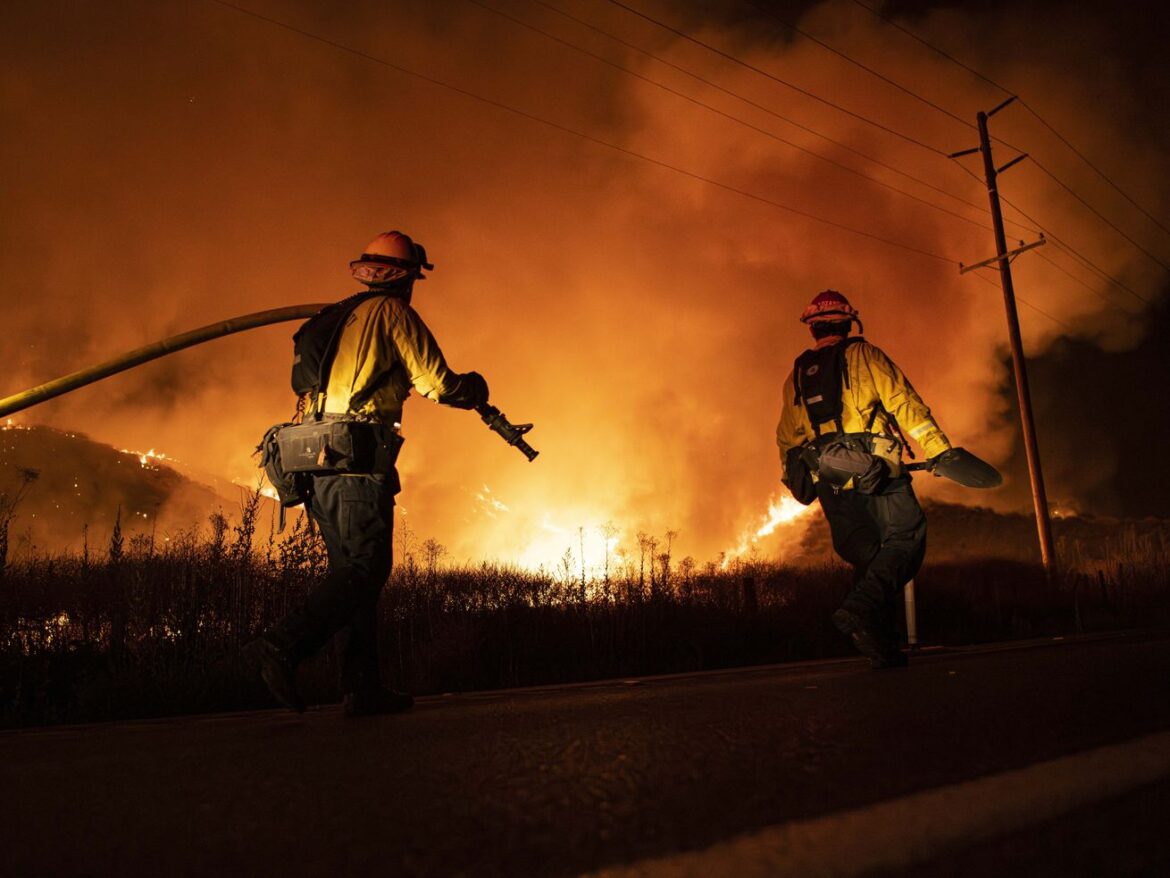Delay, deflect, downplay, and other ways fossil fuel companies block climate action.
For the past dozen years or so, every time the United Nations General Assembly holds its annual session in New York City, climate activists hit Manhattan to protest outside. They call it Climate Week. And this week has been a big one, with tens of thousands of protestors demonstrating as part of the New York March to End Fossil Fuels.
After a summer of extreme weather, Vox’s daily news podcast Today, Explained is tackling Climate Week with some help from a scientist — one who’s been at the center of climate science since before it was cool, and has some ideas on how we can keep the planet from getting too hot.
Michael Mann is a professor at the University of Pennsylvania and author of the new book Our Fragile Moment: How Lessons from Earth’s Past Can Help Us Survive the Climate Crisis. Mann is perhaps best known for the “hockey stick curve” in a 1998 paper he co-published about the planet’s rapidly rising temperature after a mostly steady millennium.
Mann spoke with Today, Explained host Sean Rameswaram about his experience fighting climate denialism, and the new tactics that have emerged from the fossil fuel industry and the groups it supports. Read on for an excerpt of the conversation, edited and condensed for length and clarity, and listen to the full conversation wherever you find podcasts.
What is the hockey stick curve?
It was an estimate that we published 25 years ago now of how temperatures had varied over the past thousand years. We have widespread thermometer measurements that go back about a century and a half that tell us the planet has warmed up over that time period, a better part of 2 degrees Fahrenheit now. But what the short instrumental record doesn’t tell us is how unusual that warming is. The shape resembles a hockey stick because there’s the upturned blade, which is the dramatic warming of the past century and a half, which coincides, of course, with the Industrial Revolution and the burning of carbon and greenhouse gas pollution. But that blade emerges from a fairly flat preceding nine centuries. You might think of that as the handle of this upturned hockey stick. And so it got a name and because it really conveyed just how profound an impact we are having on the climate today, it became an iconic graph in the climate debate, and it led me to the center of that fractious debate.
Now, a lot of people don’t see scientific papers in their day-to-day lives. How did people get exposed to your hockey stick graph? How did it become your greatest hit?
At the time that the hockey stick study was published, by the mid-1990s, there were a number of studies that really demonstrated quite definitively that we were warming the planet, but they were fairly technical. Whereas when we published the hockey stick curve in 1998, it told a very clear story. And it was widely reproduced. It became a symbol in the climate change debate because it told a simple story. I think in the scientific community, it was recognized as a landmark achievement, if I say so myself. But in the political realm, critics of climate science, [those with] fossil fuel interests, and those promoting an agenda of climate inaction saw the hockey stick as a threat because it did tell a simple story. It was easy to understand from looking at that graph that we were having this profound impact on the planet.
Where was the negativity coming from?
The usual suspects, and I document this in The Hockey Stick and the Climate Wars book that I wrote about my experiences some years ago. It was a virtual constellation of think tanks and front groups, most of which were tied to fossil fuel companies or conservative donors like the Koch brothers or the Scaife Foundations. Any time the finding of science has found itself on a collision course with powerful vested interests, those vested interests have often sought to discredit the science.
It sounds like you’re talking about climate denialism here. Can you remind us about an era in which it was easy to say, “Yeah, none of that’s happening. None of this is real.”
Yeah. If you go back a couple of decades, as we sometimes say, the signal was still emerging from the noise. The science very clearly established that we were warming the planet and changing the climate in various ways. But in terms of public understanding, the public wasn’t really seeing it yet in the form of the sorts of unprecedented extreme weather events that we’re now seeing and the coastal inundation and droughts and heatwaves and wildfires and floods. It wasn’t yet that apparent. There was still a window of opportunity for climate polluters and those promoting their agenda. There was really an effort to discredit the science, often by discrediting the scientists. And I found myself at the receiving end of personal attacks that were intended to discredit the hockey stick curve because it was perceived as such a threat.
What kind of attacks?
I received a white powder in the mail. The FBI had to come to my office. There was police tape over my office. They had to send out the sample to the lab to have it tested. It turned out it was cornmeal or something. It was intended to intimidate and scare me. And demands from conservative politicians that I be fired from my job at the University of Pennsylvania. Fox News, the Wall Street Journal, vilifying me to their audiences. It was a full-throttle effort to discredit me because of the threat of the hockey stick curve that I had published.
Okay, 25 years later, are you still being bullied?
Well, the battle has largely moved on. We’ve really evolved mostly past denialism because the impacts of climate change are staring us in the face. They’ve become so obvious we can see them play out in real time. And there is a resurgence, a superficial resurgence of denial, like on social media, Twitter, for example. But it’s not real in the sense that the actual public survey work that’s been done shows that it remains a fairly small fraction of the American public, roughly 10 percent, who are climate dismissives. So in reality, most people have moved on. The vast majority of the public gets it. They understand because they can see it, they can feel it. It’s not like the fossil fuel industry has given up. They’re still doing everything they can to prevent us from moving on. But they’ve largely moved away from [outright] denialism toward these softer denialist tactics.
What do you call it if it’s not climate denialism anymore? What are we facing now?
So there are other D-words. There’s delay. There’s division. Get climate advocates fighting with each other about, like, whether they’re vegans or not or whether they drive a car or not. Get climate advocates fighting with each other so you divide and conquer the movement. That’s division. Delay: “Oh, look, we can fix the problem with geoengineering, with carbon capture down the road. Trust us, we’ll be able to fix it.” So “let us continue to burn fossil fuels now. We will fix it later.” Delay. And that’s what they want. They want people disengaged on the sidelines rather than on the front lines. We see these tactics literally playing out today.
There’s an article that just recently appeared in the Wall Street Journal detailing how Rex Tillerson, the former CEO of ExxonMobil, who had been lauded as the next generation of Exxon leadership — he was not a climate denier. He accepted that climate change is real — there was a real effort by Tillerson and ExxonMobil at that time to present this public face of climate acceptance — because it had already become difficult to deny it was happening. People understood it was happening. It wasn’t credible to deny it. And so it was, “Yes, we accept the science,” but the D-word here is downplaying. And in the article, the Wall Street Journal makes it very clear, based on internal documents that show a different side of ExxonMobil and Rex Tillerson, that they were actively campaigning to downplay the detrimental impacts of the climate crisis while playing up techno fixes like geoengineering. In fact, Rex Tillerson was quoted saying that climate change is an engineering problem.
The idea here is, look, we can continue to extract and burn and sell and burn fossil fuels because we have all these techno fixes, other things that we can do to the climate system: trying to offset the warming by shooting particles into the stratosphere that reflect sunlight or dumping iron into the ocean to fertilize the algae that will take up the carbon dioxide, take it out of the atmosphere. Or massive carbon capture, we’ll just suck the CO2 back out of the atmosphere. That can’t be very hard, right? Well, actually, no. It’s really expensive and really difficult to do. And so [there are] these very elaborate schemes to try to somehow put the genie back in the bottle rather than the obvious solution, which is to keep the genie in the bottle in the first place.
By which you mean what?
Not extracting and burning fossil carbon and putting it into the atmosphere.
And a lot of that would have to be on the individual because obviously, if individuals want to burn fossil fuels, this is a country where they’re going to find someone willing to help them do so. How much of the climate delayism is being pushed on the individual at this moment?
It’s a great point. And actually I would even classify that with a different D-word, what I call deflection, which is to say there’s been an effort by the same bad actors to deflect the conversation away from regulation and the needed policies which will hurt their bottom line — carbon pricing, cap and trade, what have you — to redirect the conversation against those systemic changes and policies that will hurt them financially and turn attention instead to individuals. It’s the same thing, for example, that the beverage industry did to try to prevent the passage of bottle bills. They didn’t want deposits on bottles and cans, even though that was a systemic policy that would help clean up the countryside and get people to recycle. They didn’t want that because it would hurt their bottom line.
So instead, they ran a campaign to convince us, and there’s the famous Crying Indian commercial, early 1970s, the tearful Native American. It was an underhanded effort by the beverage industry to convince us that we didn’t need regulation, we didn’t need bottle bills.
That same playbook is being used today by carbon polluters. In the early 2000s, the very first widely used and publicized individual carbon footprint calculator, where you could calculate your carbon footprint and figure out how to change your lifestyle to make it smaller, was created and publicized by British Petroleum. British Petroleum wanted you so focused on your individual carbon footprint that you failed to note theirs.
That’s why we need policies, because individuals can’t put a price on carbon themselves. They can’t block the construction of new fossil fuel infrastructure. These are all things that only our politicians can do. And so that’s where we are today. Deflection remains one of the key tactics. And a lot of good people have fallen victim to it. A lot of environmentalists will tell you, yeah, the solution is just us decreasing our carbon footprint. “You need to become a vegan, you can’t have children, you shouldn’t fly.” Ironically, that framing helps the fossil fuel industry even more because it plays to this notion on the right that climate action is about controlling people’s lifestyles.
You’re reminding me of one of my favorite Onion headlines from, I don’t know, 2010, I think, which was, “‘How bad for the environment can throwing away one plastic bottle be?’ 30 million people wonder.” This isn’t completely on the individual. But if 300 million Americans woke up tomorrow and said, “I never want to put gas in my car ever again,” that would change the world.
That’s absolutely true. One of the things that we understand, though, is that people in general won’t make voluntary decisions to change their lifestyle in a way that would appear to impact their quality of life unless there’s some incentive. And that’s why you need a financial incentive. It needs to be cheaper for people to purchase energy that’s not warming the planet and destroying the environment. Because right now we’ve got our thumb on the wrong end of the scale. And so you need that price signal. You need policies that will collectively move everybody in the right direction without them having to actively think about it.
I want to ask you about another D-word that I think is related to the lack of policies that are going to make enough of a difference to save this planet. And that, of course, is doom. Climate doomerism.
Yeah. And doomism has actually been weaponized by bad actors to convince even environmentalists that, “Hey, it’s too late to do anything anyway, so you might as well just give up trying to solve the climate crisis.” People who are ostensible climate advocates and environmentalists insist that it’s too late, and we just have to accept our fate. There are events, like mass extinction events in the past, that some of these doomists will point to and say, “Look what happened to the dinosaurs, what happened during the so-called Great Dying 250 million years ago when 90 percent of all species died out because of a massive release of carbon into the atmosphere through an episode of massive volcanism, that’s happening today.” There are prominent actors in the climate space who are literally making this claim. And they’re doing so by misrepresenting what the record of Earth history actually tells us about those events. We are at a fragile moment. We’re not yet past the point of no return. But if we don’t take substantial action and do so immediately, then we are due for some of those potential worst-case scenarios. So it is still up to us.
So it sounds like you’re not a doomer.
I’m not. If the science indicated that it was too late for us to prevent the worst consequences of climate change, I would have to be truthful as a scientist about that. Fortuitously, that’s not what the science does tell us. So I can in good faith be out there trying to explain that to people.
Is there a D-word out there that we haven’t talked about — not denialism, divisionism, delayism, doomism, deflection — that people can attach themselves to in a moment where critical decisions that are made could really shift the outcome?
Yes … We have to be determined now to take the actions that are necessary while we still can. Let’s be clear. We should all do everything we can within the constraints of our own lifestyles to minimize our environmental impact and to minimize our carbon footprint. But the most important thing an individual can do is to use their voice and their vote, because the policies that we need in place to decarbonize our economy, to lower carbon emissions by 50 percent over the next decade, the only way we can accomplish that is with policy. And so we need to vote for politicians who will do what’s right by us and act on climate, rather than the politicians who too often are simply acting as rubber stamps for polluters.



